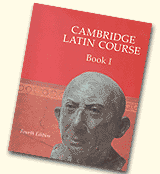Caecilius is working in the forum, the central marketplace where everyone goes to meet, trade and gossip! Luckily, he catches sight of three merchants he wants to deal with...

It's time to leave the house, go into town and do business ("negotium") with some of the local merchants! The three we'll meet in this Stage represent some of the most interesting trades in Pompeii.
The Stories
Time to "brush-up" on mythology! Caecilius has commissioned a painter to decorate his dining-room with a famous Roman subject. There's a superhero, a lion and a wooden club; it can only be...
Razors at the ready! A cheeky poem leads to a very close shave for Caecilius at the barber's.
The slave-trader is happy with his sale, and Caecilius is more than happy with his purchase - but his wife is less than amused. There could be trouble ahead!
Practising the Language
Activities for vocabulary revision and language practice:
Test your Vocabulary is against the clock and can be set to all words in this stage, up to this stage, etc.
Word Endings exercises are based on the Practising the Language section in the Books, and follow this format. Click here for more information.
Word Endings activities are based on the Practising the Language section of each Stage, and all follow the same format. The user is given a sentence in English together with the same sentence in Latin, but with one or more endings to be chosen from a drop down list. In most exercises the endings omitted are restricted to one particular part of speech (noun, verb or adjective). For this type of exercise language information is provided. This can be called up by the user at any time by clicking on LANGUAGE INFO. But in some exercises, all noun, verb and adjective endings are omitted. For this more demanding exercise, LANGUAGE INFO provides only reference to the relevant pages of the Cambridge Latin Course.
Sorting Words asks you to sort words by meaning, case, etc.
Practising the Language exercises are digital versions of exercises in the Cambridge Latin Course textbooks.
Please note: the Cultural Background weblinks section has been removed.



